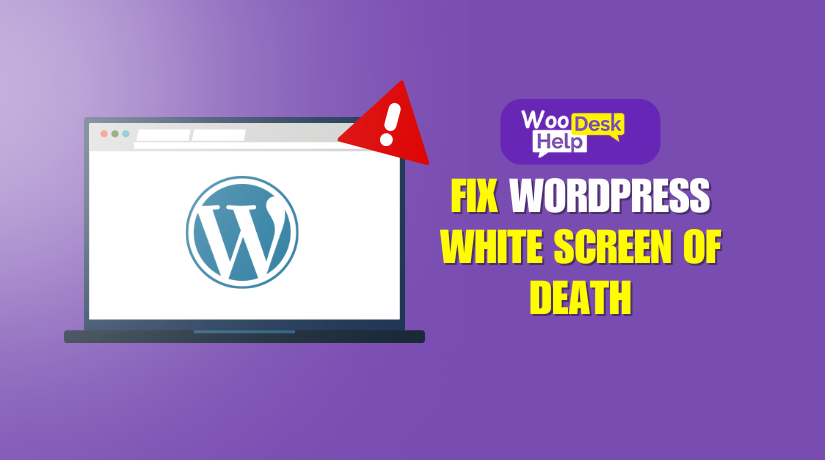
Fix WordPress White Screen of Death with Simple Troubleshooting Steps
Table of Contents
- Introduction
- What is the WordPress White Screen of Death?
- Common Causes of the White Screen in WordPress
- Importance of Addressing the WordPress White Screen Promptly
- How to Fix WordPress White Screen of Death (WSoD)
- Preventive Measures for Avoiding the WordPress White Screen of Death
- Conclusion
Introduction
Encountering a blank white screen on your WordPress site can be alarming. This issue, commonly known as the WordPress White Screen of Death (WSoD), renders your website inaccessible to both administrators and visitors. Understanding its causes and solutions is crucial for maintaining your site’s health and ensuring a seamless user experience.
What is the WordPress White Screen of Death
The WordPress White Screen of Death refers to a situation where your website displays a plain white screen instead of the expected content. This phenomenon often occurs without any error messages, making it challenging to diagnose the root cause. Both the front end and the admin dashboard (wp-admin) can be affected, leaving administrators and visitors unable to access the site. In some cases, users may encounter a WordPress login blank white screen, preventing them from logging into their accounts.
Common Causes of the White Screen in WordPress
Plugin Conflicts: Incompatible or poorly coded plugins can interfere with your site’s operations, leading to the white screen in WordPress. This often occurs after installing or updating a plugin, resulting in a WordPress blank page after plugin update.
Theme Issues: A faulty or incompatible theme can cause display problems, such as a WordPress white screen after theme installation. This happens when the new theme conflicts with existing plugins or the WordPress core.
Memory Limit Exhaustion: WordPress relies on PHP scripts that require memory to run. If these scripts exceed the allocated memory, it can lead to a WordPress white screen. This is often due to resource-intensive plugins or themes consuming more memory than allowed.
Syntax Errors in Code: Errors in custom code snippets or theme files can disrupt your site’s operation, leading to the WordPress white screen. Even minor mistakes, like a missing semicolon or an extra bracket, can render the site inaccessible.
PHP Compatibility Issues: Updating your server’s PHP version without ensuring compatibility can result in a WordPress white screen after PHP update. It’s crucial to verify that all themes and plugins are compatible with the new PHP version.
Site Migration Problems: Migrating your site to a new server or domain can lead to the WordPress white screen of death after migration due to configuration issues, such as incorrect database settings or missing files.
URL Changes: Modifying your site’s URL without proper adjustments can cause a WordPress white screen after changing URL. This occurs when the new URL isn’t correctly reflected in the WordPress settings or database, leading to loading issues.
Importance of Addressing the WordPress White Screen Promptly
Ignoring the WordPress white screen of death can have serious consequences:
- Loss of Traffic and Revenue
When your website displays a white screen, visitors cannot access your content or services. This unavailability can lead to a significant drop in traffic, as users may seek information or products elsewhere. For businesses, this can result in lost sales and decreased revenue. Ensuring your site is operational minimizes the risk of losing both new and returning visitors.
- Negative Impact on Search Engine Rankings
Search engines prioritize websites that are reliable and consistently accessible. Extended periods of downtime due to issues like the WSoD can lead to lower rankings in search results, making it more challenging for potential visitors to find your site. Maintaining site uptime is essential for preserving and improving your search engine visibility.
- Diminished User Trust and Credibility
Frequent or prolonged instances of the WSoD can erode user trust. Visitors expect websites to function correctly; encountering errors undermines their confidence in your site’s reliability. This loss of trust can deter users from returning, damaging your brand’s reputation. Promptly resolving such issues demonstrates a commitment to providing a dependable user experience, which is vital for building and retaining an audience.
- Potential Security Vulnerabilities
While the WSoD is often a result of internal errors, it can sometimes indicate deeper issues, such as security vulnerabilities. Hackers may exploit these weaknesses, leading to data breaches or further site disruptions. Addressing the white screen issue promptly allows you to identify and rectify potential security threats, safeguarding your site and its users.
How to Fix WordPress White Screen of Death (WSoD)
Experiencing the WordPress White Screen of Death (WSoD) can be alarming, but it’s a common issue with several potential solutions. Here’s a step-by-step guide to help you identify and resolve the problem:
- Clear Your Cache
Cached data can sometimes cause display issues, leading to a white screen in WordPress. To address this:
- Clear Browser Cache: Access your browser settings and clear browsing data.
- Clear WordPress Cache: If you use a caching plugin, clear its cache through the plugin settings.
After clearing caches, refresh your site to see if the issue persists.
- Enable Debugging Mode
Activating WordPress’s debugging mode can help identify errors causing the WordPress white screen:
- Access wp-config.php:Use an FTP client to locate this file in your site’s root directory.
- Edit the File: Open wp-config.php and find the line define(‘WP_DEBUG’, false);. Change it to define(‘WP_DEBUG’, true);.
This will display error messages on your site, indicating the source of the problem.
- Deactivate All Plugins
Plugins can conflict and cause the WordPress white screen of death:
- Access Plugins Folder: Using FTP, navigate to wp-content/plugins/.
- Rename the Folder: Change the folder name to plugins_deactivated. This will deactivate all plugins.
If your site returns, rename the folder back to plugins and reactivate each plugin one by one, refreshing your site each time to identify the problematic plugin.
- Switch to a Default Theme
Themes can also cause conflicts leading to a WordPress website white screen:
- Access Themes Folder: Via FTP, go to wp-content/themes/.
- Rename Active Theme Folder: Rename your current theme’s folder to something like theme_old.
WordPress will revert to a default theme. If this resolves the issue, the problem lies with your theme.
- Increase PHP Memory Limit
Insufficient memory can lead to the wp white screen of death:
- Edit wp-config.php: Add the line define(‘WP_MEMORY_LIMIT’, ’64M’); before the line that says /* That’s all, stop editing! Happy blogging. */.
This increases the memory limit to 64MB. If the issue persists, you may need to set a higher value or contact your hosting provider.
- Check for Syntax Errors
Errors in your site’s code can cause issues like the WordPress editor white screen:
- Review Recent Changes: If you’ve recently edited theme or plugin files, revert those changes.
- Use Debugging Tools: Utilize tools like WP_DEBUG to identify and fix errors.
- Restore from Backup
If all else fails:
- Use a Recent Backup: Restore your site to a previous state when it was functioning correctly.
Preventive Measures for Avoiding the WordPress White Screen of Death)
While addressing the WordPress white screen of death is important, preventing it from happening again is equally crucial. Implementing these preventive measures ensures a more stable and reliable WordPress website.
- Regularly Update WordPress Core, Themes, and Plugins
One common cause of the wp white screen of death is outdated software. WordPress, themes, and plugins all receive regular updates that fix known bugs and improve security. To stay ahead of issues:
- Check for Updates Weekly: Set a routine to review updates for the WordPress core, themes, and plugins.
- Read Change Logs Before Updating: Knowing what’s changed helps identify if a new version might cause a wordpress blank screen wp admin or other issues.
- Test Updates on a Staging Site: Before applying updates to your live site, use a staging environment. This prevents issues like the wordpress white screen after plugin update from affecting your live audience.
- Keep a Consistent Backup Strategy
A robust backup strategy can save you from extended downtime if a white screen in WordPress occurs. Having recent backups allows you to quickly restore your site to a functioning state.
- Automated Daily Backups: Use a reliable WordPress backup plugin that automatically backs up files and databases every day.
- Store Backups in Multiple Locations: Keep copies in the cloud, on your server, and on an external drive.
- Regularly Test Your Backups: Verify that you can restore your site from backups to ensure they work when needed.
- Use Quality Themes and Plugins from Trusted Sources
The wordpress white screen after theme installation often results from poorly coded or incompatible themes. Similarly, unreliable plugins can trigger a wordpress website white screen. To minimize these risks:
- Choose Themes from Reputable Marketplaces: Look for themes with positive reviews, active support, and frequent updates.
- Only Install Trusted Plugins: Ensure plugins are actively maintained and have good ratings. Avoid using abandoned or untested plugins.
- Limit the Number of Plugins: More plugins mean more potential conflicts. Stick to the essentials to reduce the risk of a WordPress blank page after plugin update.
- Optimize Your Site’s Performance
Performance optimizations help reduce memory issues that can cause a wordpress white screen after PHP update. By improving how your site uses resources, you can prevent memory-related crashes.
- Enable Caching:A caching plugin can decrease the server load and prevent memory exhaustion.
- Use a Content Delivery Network (CDN): Offloading static assets to a CDN reduces strain on your server.
- Monitor Server Resources: Keep an eye on your site’s memory usage. If your site frequently exceeds its allocated memory, consider upgrading your hosting plan.
- Regularly Review Custom Code and Files
Custom code changes can easily cause a wordpress editor white screen. Frequent reviews ensure that errors are caught before they cause major issues.
- Audit Custom Functions Periodically: Check your functions.php file and other custom code for syntax errors or deprecated functions.
- Use a Development Environment: Always test new code in a local or staging environment before applying it to the live site.
- Implement Security Best Practices
Security vulnerabilities can sometimes lead to unexpected issues, including a wordpress login blank white screen. By strengthening your site’s security, you can reduce the risk of disruptions.
- Use Strong Passwords and Two-Factor Authentication: Protect admin accounts with strong, unique passwords and enable two-factor authentication.
- Install a Security Plugin: Plugins like Wordfence or Sucuri can monitor your site and prevent malicious changes that could cause a white screen of death.
- Keep Your Site Clean: Regularly scan for malware or unwanted code injections. A clean site is less likely to encounter unexpected errors.
- Maintain a Reliable Hosting Environment
Your hosting environment plays a significant role in your site’s stability. A reliable hosting provider can help prevent issues like the wordpress white screen after changing URL by ensuring server-level configurations are correct and up to date.
- Choose a Reputable Host: Opt for hosting providers that specialize in WordPress and offer regular updates and high performance.
- Monitor Uptime and Performance: Use uptime monitoring tools to quickly detect and address server-related problems.
- Invest in Managed Hosting: Managed WordPress hosting can handle updates, backups, and security, reducing the chances of running into a wordpress white screen of death after migration.
Conclusion
WordPress White Screen of Death is a frustrating but manageable problem. Understanding its common causes—like plugin conflicts, memory limits, or code errors—and addressing them promptly ensures your site stays accessible. By keeping your themes, plugins, and WordPress core up to date, maintaining a solid backup strategy, and following best practices, you’ll minimize downtime and protect your website’s reliability and credibility.




